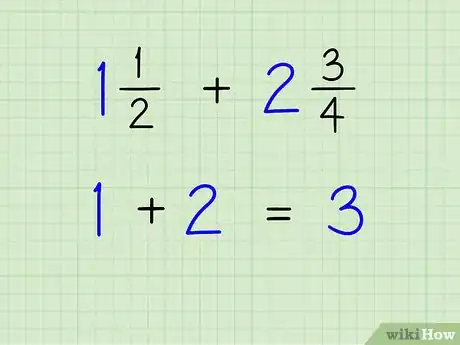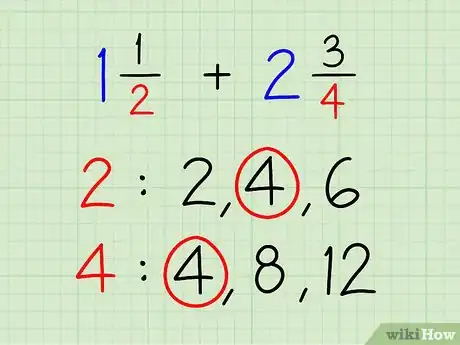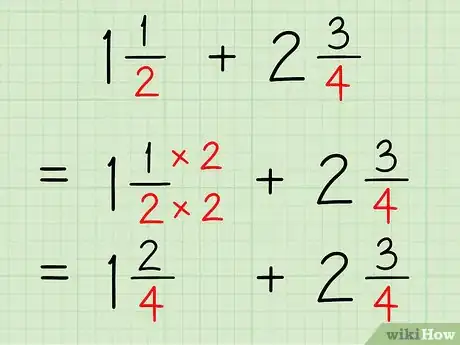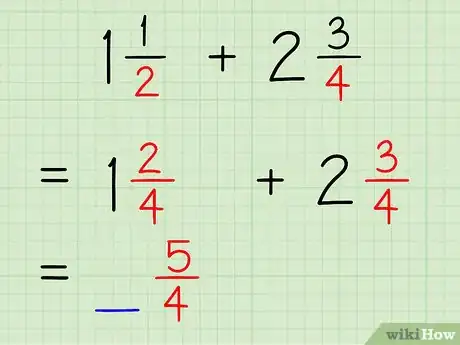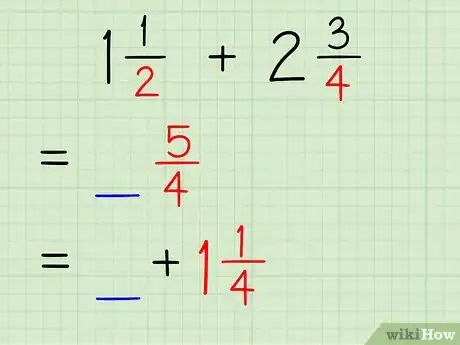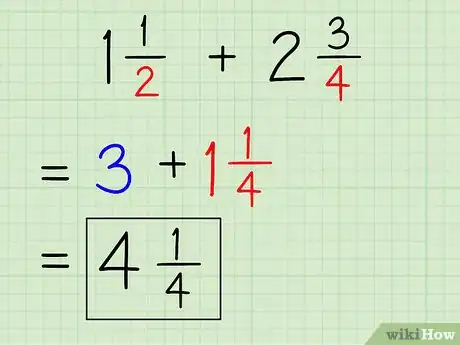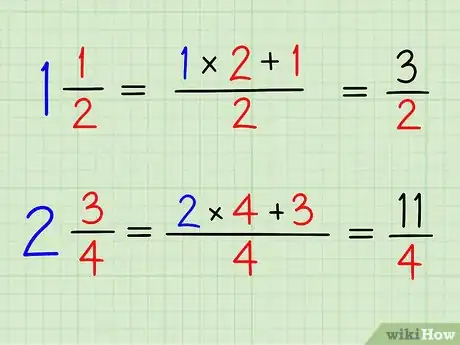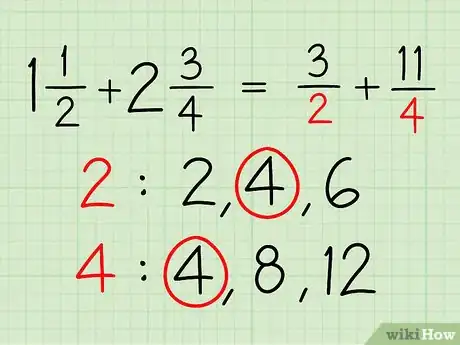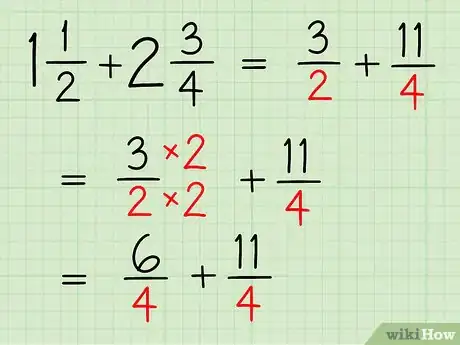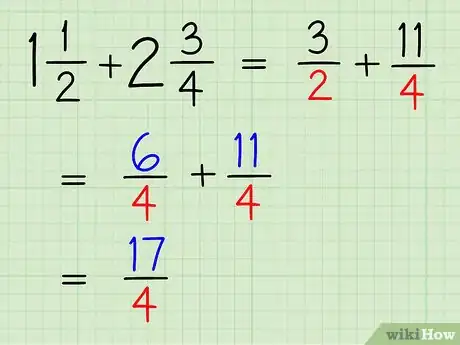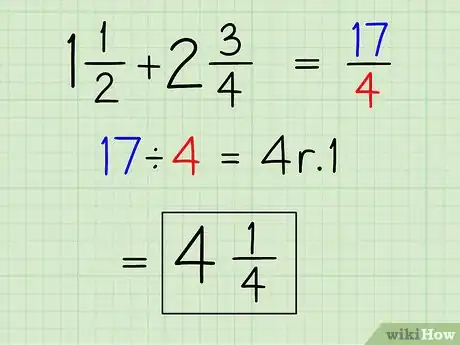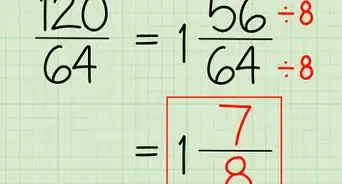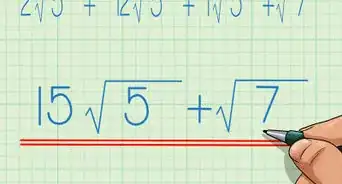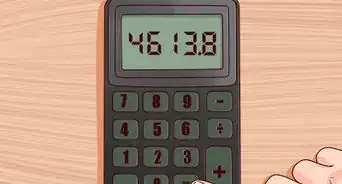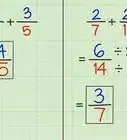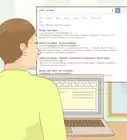This article was co-authored by Mario Banuelos, PhD. Mario Banuelos is an Assistant Professor of Mathematics at California State University, Fresno. With over eight years of teaching experience, Mario specializes in mathematical biology, optimization, statistical models for genome evolution, and data science. Mario holds a BA in Mathematics from California State University, Fresno, and a Ph.D. in Applied Mathematics from the University of California, Merced. Mario has taught at both the high school and collegiate levels.
There are 9 references cited in this article, which can be found at the bottom of the page.
This article has been viewed 145,149 times.
A mixed number is a whole number next to a fraction, such as 5 ½, and can be difficult to add. If you want to learn how to add mixed numbers, read this article.
Steps
Adding the Whole Numbers and Fractions Separately
-
1Add the whole numbers together. The whole numbers are 1 and 2, so 1+2 =3.[1]
-
2Find the lowest common denominator (LCD) of both fractions.[2] The LCD is the lowest number that is evenly divisible by both numbers.[3] One way to find the LCD is just to write out the multiples of each denominator and see where they match for the first time. Since the denominators of the fractions are 2 and 4, the LCD is 4, because 4 is the smallest number that is divisible by both 2 and 4.[4]Advertisement
-
3Convert the fractions to have the LCD as their denominator. Before you can add the fractions, they have to have 4 as their denominator, so you have to make the fractions maintain their value while having a new base. Here's how to do it:
- Since the denominator of the fraction 1/2 has to be multiplied by 2 to get 4 as the new base, you should multiply the numerator 1 by 2 as well. 1x2=2, so the new fraction is 2/4. The fraction 2/4 = 1/2, but has been put in a larger ratio to have a larger base. This means that the numbers are equivalent fractions. They have a different base, but their value remains the same.
- Since the fraction 3/4 already has the base of 4, you don't have to change it.
-
4Add the fractions. Once you have a common denominator, the fractions can be added by simply adding the numerators.[5]
- 2/4 + 3/4 = 5/4
-
5Convert any improper fractions into mixed numbers. An improper fraction is a fraction where the numerator is equal to or larger than the denominator. You need to convert the improper fraction into a mixed number before you can add it to the sum of the whole numbers. Since the original problem used mixed numbers, your answer should use mixed numbers too. Here's how to do it:[6]
- First, divide the numerator by the denominator. Do long division to divide 4 into 5. 4 goes into 5 1 time. This means that the quotient is 1. The remainder, or the number that is left over, is 1.
- Make your quotient the new whole number. Take your remainder and place it over the original denominator to finish converting the improper fraction into a mixed number. The quotient is 1, the remainder is 1, and the original denominator was 4, so the final answer is 1 1/4.
-
6Add the sum of the whole numbers and the sum of the fractions. To get your final answer, you have to add the two sums you found. 1 + 2 = 3 and 1/2 + 3/4 = 1 1/4, so 3 + 1 1/4 = 4 1/4.[7]
Converting the Mixed Numbers to Improper Fractions and Adding Them
-
1Convert the mixed numbers into improper fractions. You can do this by multiplying the denominator and whole number of a mixed number, and then adding this to the numerator of the fraction of the mixed number.[8] Your answer will be the new numerator while the denominator remains the same.[9]
- To convert 1 1/2 to a mixed number, multiply the whole number 1 by the denominator 2, and then add it to the numerator. Put your new answer over the original base.
- 1 * 2 = 2, and 2 + 1 = 3. Place the answer 3 over the original denominator and you have 3/2.
- To convert 2 3/4 to a mixed number, multiply the whole number 2 by the denominator 4. 2 * 4 = 8.
- Next, add this number to the original numerator and place it over the original denominator. 8 + 3 = 11. Put 11 over 4 to get 11/4.
- To convert 1 1/2 to a mixed number, multiply the whole number 1 by the denominator 2, and then add it to the numerator. Put your new answer over the original base.
-
2Find the lowest common multiple (LCM) of both the denominators. The LCM is the lowest number that is evenly divisible by both numbers.[10] If the denominators are already the same, skip this step.
- If one of the denominators is divisible by the other, the larger denominator is the LCM. The LCM of 2 and 4 is 4 because 4 is evenly divisible by 2.
-
3Make the denominators the same. You can do this by finding equivalent fractions. Multiply the denominator by a number that will give you the LCM as the product.[11] Multiply the numerator by the same number. Do this with both fractions.
- Since the denominator of 3/2 has to be multiplied by 2 to get the new denominator of 4, you should multiply the numerator by 2 to find the equivalent fraction of 3/2. 3 * 2 = 6, so the new fraction is 6/4.
- Since 11/4 already has the denominator of 4, you're in luck. You don't have to change it.
-
4Add the two fractions. Now that the denominators are the same, just add the numerators to get your answer while keeping the same base.[12]
- 6/4 + 11/4 = 17/4.
-
5Convert the improper fraction back into a mixed fraction. Since the original problem was in mixed number form, you can convert it back into a mixed number.[13] Here's how to do it:[14]
- First, divide the numerator by the denominator. Divide 4 into 17. 4 goes into 17 4 times, so the quotient is 4. The remainder, or the number that is left over, is 1.
- Make your quotient the new whole number. Take your remainder and place it over the original denominator to finish converting the improper fraction into a mixed number. The quotient is 4, the remainder is 1, and the original denominator was 4, so the final answer is 4 1/4.
Community Q&A
-
QuestionHow do I add mixed fractions if there is no LCM?
 DonaganTop AnswererThere is always a lowest common denominator, even if it's just the product of the denominators.
DonaganTop AnswererThere is always a lowest common denominator, even if it's just the product of the denominators. -
QuestionI don't get it. Can you word this easier?
 DonaganTop AnswererThe easiest way is Method 1 above. In that example, you first add the whole numbers: 1 + 2 = 3. Remember the 3. We'll need it later. Next add together the two fractions: ½ + ¾. Before you can add fractions, their denominators must be made equal to each other. The easiest thing to do here is double the first denominator (2) to make it the same as the second denominator (4). So we double the denominator in the fraction ½. In order not to change the value of that fraction, we must also double the numerator. Thus, ½ becomes 2/4. Now we can add the two fractions together: 2/4 + 3/4 = 5/4. 5/4 = 1¼. Get the final answer by adding 1¼ to the 3 we got earlier. 1¼ + 3 = 4¼.
DonaganTop AnswererThe easiest way is Method 1 above. In that example, you first add the whole numbers: 1 + 2 = 3. Remember the 3. We'll need it later. Next add together the two fractions: ½ + ¾. Before you can add fractions, their denominators must be made equal to each other. The easiest thing to do here is double the first denominator (2) to make it the same as the second denominator (4). So we double the denominator in the fraction ½. In order not to change the value of that fraction, we must also double the numerator. Thus, ½ becomes 2/4. Now we can add the two fractions together: 2/4 + 3/4 = 5/4. 5/4 = 1¼. Get the final answer by adding 1¼ to the 3 we got earlier. 1¼ + 3 = 4¼. -
QuestionHow do I divide mixed fractions and then subtract with a proper fraction?
 DonaganTop AnswererIf you're asking about first dividing mixed numbers, you must convert both mixed numbers to improper fractions, invert the divisor, and multiply the two fractions together. Then subtract the proper fraction from the product you just found. Do this by converting one or both fractions until they have the same denominator. Perform the subtraction and then (if the difference is an improper fraction) convert the difference to a mixed number if you wish.
DonaganTop AnswererIf you're asking about first dividing mixed numbers, you must convert both mixed numbers to improper fractions, invert the divisor, and multiply the two fractions together. Then subtract the proper fraction from the product you just found. Do this by converting one or both fractions until they have the same denominator. Perform the subtraction and then (if the difference is an improper fraction) convert the difference to a mixed number if you wish.
References
- ↑ https://www.basic-mathematics.com/adding-whole-numbers.html
- ↑ https://www.mathsisfun.com/least-common-denominator.html
- ↑ https://virtualnerd.com/act-math/algebra/rational-expressions-equations/least-common-denominator-definition
- ↑ https://www.ixl.com/math/lessons/adding-mixed-numbers
- ↑ https://www.mathsisfun.com/numbers/fractions-mixed-addition.html
- ↑ https://www.mathsisfun.com/improper-fractions.html
- ↑ https://www.calculatorsoup.com/calculators/math/mixednumbers.php
- ↑ https://www.mathsisfun.com/improper-fractions.html
- ↑ https://www.khanacademy.org/math/arithmetic/fraction-arithmetic/arith-review-mixed-number/v/changing-a-mixed-number-to-an-improper-fraction
- ↑ https://www.mathsisfun.com/least-common-denominator.html
- ↑ https://www.mathsisfun.com/least-common-denominator.html
- ↑ https://www.mathsisfun.com/numbers/fractions-mixed-addition.html
- ↑ https://www.mathsisfun.com/improper-fractions.html
- ↑ https://www.khanacademy.org/math/arithmetic/fraction-arithmetic/arith-review-mixed-number/v/changing-an-improper-fraction-to-a-mixed-number
About This Article
To add mixed numbers, start by adding the whole numbers together. Next, find the lowest common denominator of both fractions and convert the fractions so they both have this denominator. Then, add the fractions by simply adding the numerators together. Finally, add the sum of the whole numbers and the sum of the fractions to get your final answer. For tips on converting mixed numbers to improper fractions, read on!
